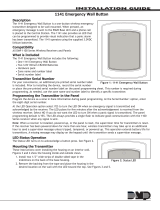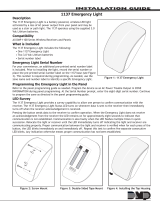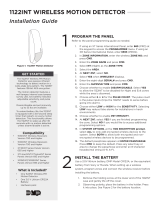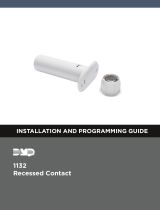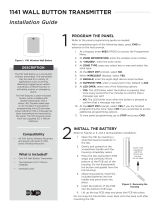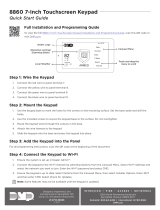Page is loading ...

DESCRIPTION
1
PROGRAM THE PANEL
Refer to the panel programming guide as needed.
1. At a keypad, enter 6653 (PROG) to access the Programmer
Menu.
Note: Steps 2 and 3 are for the 1142E to enable encryption. If
using an 1142, proceed to step 4 to continue the installation.
2. (1142E only) Navigate to System Options. At the
1100 ENCRYPTION prompt, select ALL to only add encrypted
wireless devices to the system. Select BOTH to allow both
encyrpted and non-encrypted wireless devices to be
programmed.
3. (1142E only) The default passphrase appears at the
ENTER PASSPHRASE prompt. Press CMD to keep the default.
Press any select key or area to change the passphrase and
enter an 8-character hexidecimal string (0-9, A-F).
4. In ZONE INFORMATION, enter the wireless ZONE NO:.
5. Enter the ZONE NAME.
6. Select PN (panic) as the ZONE TYPE.
7. At the NEXT ZN? prompt, select NO.
8. Select YES when WIRELESS? displays.
9. Enter the eight-digit SERIAL# and press CMD.
10. Enter in the SUPRVSN TIME (supervision time) and press CMD.
For the 1142BC applications where the transmitter may be
taken o-site, set the supervision time to zero (0).
11. At LED OPER (operation), select YES to activate or NO to
not activate the LED when a panic signal is transmitted or
acknowledged by the receiver. The LED pulses for five minutes
after the acknowledgement is received from the panel.
12. At the NEXT ZN? prompt, select YES if you are finished
programming the zone. Select NO if you would like to access
additional programming options.
The 1142 Series are wireless two-
button hold-up transmitters that can
be mounted under a counter or on a
wall. They provide a tamper switch to
identify if the unit has been removed
from its mounted location. The 1142E
features 128-bit AES encryption.
The 1142BC wireless two-button
panic transmitter is designed to clip
to a belt or pocket. Optionally, the
1142BC can be mounted under the
counter or on a wall.
Both 1142 Series units provide two
buttons that, when pressed at the
same time, send a panic message to
the control panel. They also provide
an LED that can be programmed to
provide visual indication that a panic
alarm has been transmitted.
Compatibility
All DMP XT Series and XR Series and
all 1100 Series Wireless Receivers.
To enable encryption on 1142E
models, Version 183 is required
for XT and XR Series panels and
Version 300 is required for Wireless
Receivers.
What is Included?
• One 1142 Wireless Two-Button
Transmitter
• One 3.0V Lithium CR123A Battery
• Hardware Pack
• Belt Clip (If 1142BC was ordered)
2
OPEN THE 1142
Because of the strength and the snap-on design of the plastic, the
1142 can only be opened by using a 3/16" slotted tip screwdriver.
1. Insert the screwdriver in Tab 1 and twist it clockwise as
seen in Figure 2.
2. Insert the screwdriver in Tab 2 and twist it
counterclockwise until the housing completely opens.
Tab 1
Tab 2
1142 SERIES WIRELESS
TWO-BUTTON TRANSMITTER
Installation Guide
Figure 1: 1142 Series Wireless
Two-Button Transmitter
Figure 2: Open the 1142

2 1142 INSTALLATION GUIDE | DIGITAL MONITORING PRODUCTS
1. Set aside the top housing containing the PCB and the
battery.
2. Place the base housing in the desired location with the
LED cut–out facing you.
3. Use the two supplied Phillips screws to mount the base.
4. Align the top housing and LED cut–out with the base
housing and LED cut–out and snap into place. Ensure
the tamper in the top housing is aligned with the
tamper location on the base housing.
For UL listed holdup installations, mount the 1142 in
a permanent location.
Under-the-Counter Mounting
4
SELECT A LOCATION
The 1142 provides a survey capability to allow one person to
confirm communication with the wireless receiver or panel
while the cover is removed. This allows you to determine the
best location for the 1142.
Check the Location Using a Survey LED
1. Hold the 1142 in the exact desired location.
2. Press the tamper switch to send data to the panel and
determine if communication is confirmed or faulty. See
Figure 3 for tamper switch and LED locations.
Confirmed: If communication is confirmed, the
survey LED turns on when data is sent to the
receiver and o when acknowledgement is
received.
Faulty: If communication is faulty, the LED remains
on for about 8 seconds or flashes multiple times in
quick succession.
3. Relocate the 1142 or receiver until the LED confirms
clear communication. Proper communication between
the 1142 and panel is verified when for each press
or release of the tamper switch, the LED blinks
immediately on and immediately o.
5
INSTALL THE BATTERY
Use a 3.0V lithium battery or a DMP Model CR123A battery. It is recommended for UL installations to use
either an Energizer 123 battery or a CR123A battery manufactured by Panasonic or Tekcell. Keep in mind,
when setting up a wireless system, program zones and connect the receiver (if needed) before installing the
battery.
With the 1142 already open, observe polarity and place the battery in the holder and press it into place.
3
INSTALL THE 1142
For a permanent installation, mount the 1142 in a location
that is accessible but not visible to the attacking party. If you
programmed the 1142 with zero (0) supervision time, go to
Install the Belt Clip.
PCB COMPONENTS
PERMANENT
3.0V Lithium Battery
CR123
Permanent Mounting Holes
Tamper Location
PCB
Battery Location
Tamper Switch
Antenna
LED
Figure 3: PCB Components
Figure 4: Permanent Installation

DIGITAL MONITORING PRODUCTS | 1142 INSTALLATION GUIDE 3
6
WALK TEST THE 1142
After the 1142 has been installed, perform a Walk Test to
confirm the 1142 is communicating with the panel.
Walk Test
1. At the keypad, enter 8144 (WALK) and select WLS.
2. If the 1142 fails to check in at the keypad, relocate the
wireless device or receiver.
1. Set aside the top housing containing the PCB,
battery, and LED.
2. Align the belt clip spacer with the housing indention.
3. Using the supplied screw, secure the belt clip to the
housing.
4. Align the top housing and LED cut out with the base
housing and LED cut out and snap into place. See
Figure 5.
Install the Belt Clip
1. Open the 1142 and remove the old battery.
2. Observe polarity and place the new battery in the holder and press into place. .
3. Align the top housing and LED cut-out with the base housing and LED cut-out and snap into place. See
Figure 2.
Properly dispose of used batteries. Do not recharge, disassemble, heat above 212°F (100°C), or incinerate.
Risk of fire, explosion, and burns.
REPLACE THE BATTERY
Sensor Reset to Clear LOBAT
When the battery needs to be replaced, a LOBAT message will display on the keypad. Once the battery is
replaced, a sensor reset is required at the system keypad to clear the LOBAT message.
1. On a Thinline keypad, press and hold “2” for two seconds. On a touchscreen keypad press RESET.
2. Enter your user code if required. The keypad displays SENSORS OFF followed by SENSORS ON.
BELT CLIP
Insert
Screw
Here
Spacer
USE IT
Once the belt clip has been installed and the 1142BC housing
is secured, clip the 1142BC to a belt or pocket that is easy to
access when an emergency occurs. See Figure 6.
Use the 1142BC
Figure 5: Install the Belt Clip
Figure 6: Use the 1142BC

Designed, engineered, and
manufactured in Springfield, Missouri
using U.S. and Global Components
INTRUSION • FIRE • ACCESS • NETWORKS
2500 North Partnership Boulevard
Springfield, Missouri 65803-8877
866-266-2826 | dmp.com
© 2019 Digital Monitoring Products, Inc.
LT-0700 19064 1.04
Specifications
Battery
Life Expectancy 5 years (normal operation)
Type 3.0V lithium CR123A
Frequency Range 905-924 MHz
Dimensions
Transmitter Case 3.3" L x 1.6" W x 1.2" H
Belt Clip 1.9" L x 0.9" W x .03" H
Color Black, White
Housing material Flame retardant ABS
Patents
U.S. Patent No. 7,239,236
Ordering Information
1142-W Standard Wireless Two-Button Transmitter
1142E-W Encrypted Wireless Two-Button Transmitter
Compatibility
• 1100D Wireless Receivers
• 1100DH Wireless High Power Receivers
• 1100DI Wireless In-line Receivers
• 1100X Wireless Receivers
• 1100XH Wireless High Power Receivers
• XTLC Panels with an integrated wireless receiver
• XTLN Panels with an integrated wireless receiver
• XT50 Series Panels with an integrated wireless receiver
• XTLplus Series Panels
Certifications
FCC Part 15 Registration ID CCKPC0191
Industry Canada Registration ID 5251A-PC0191
Underwriters Laboratory (UL) Listed
• ANSI/UL636 Holdup Alarm Units and Systems Accessory
1142 SERIES WIRELESS
TWO-BUTTON TRANSMITTER
FCC INFORMATION
This device complies with Part 15 of the FCC Rules. Operation is subject to the following two conditions:
1. This device may not cause harmful interference, and
2. This device must accept any interference received, including interference that may cause undesired operation.
The antenna used for this transmitter must be installed to provide a separation distance of at least 20 cm (7.874 in.) from
all persons. It must not be co-located or operated in conjunction with any other antenna or transmitter.
Changes or modifications made by the user and not expressly approved by the party responsible for compliance could
void the user’s authority to operate the equipment.
This equipment has been tested and found to comply with the limits for a Class B digital device, pursuant to part
15 of the FCC Rules. These limits are designed to provide reasonable protection against harmful interference in a
residential installation. This equipment generates, uses and can radiate radio frequency energy and, if not installed
and used in accordance with the instructions, may cause harmful interference to radio communications. However,
there is no guarantee that interference will not occur in a particular installation. If this equipment does cause
harmful interference to radio or television reception, which can be determined by turning the equipment o and on,
the user is encouraged to try to correct the interference by one or more of the following measures:
• Reorient or relocate the receiving antenna.
• Increase the separation between the equipment and receiver.
• Connect the equipment into an outlet on a circuit dierent from that to which the receiver is connected.
• Consult the dealer or an experienced radio/TV technician for help.
INDUSTRY CANADA INFORMATION
This device complies with Industry Canada Licence-exempt RSS standard(s). Operation is subject to the following two
conditions:
1. This device may not cause interference, and
2. this device must accept any interference, including interference that may cause undesired operation of the device.
Le présent appareil est conforme aux CNR d’Industrie Canada applicables aux appareils radio exempts de licence.
L’exploitation est autorisée aux deux conditions suivantes:
1. l’appareil ne doit pas produire de brouillage, et
2. l’utilisateur de l’appareil doit accepter tout brouillage radioélectrique subi, même si le brouillage est susceptible
d’en compromettre le fonctionnement.
This system has been evaluated for RF Exposure per RSS-102 and is in compliance with the limits specified by Health
Canada Safety Code 6. The system must be installed at a minimum separation distance from the antenna to a general
bystander of 7.87 inches (20 cm) to maintain compliance with the General Population limits.
L’exposition aux radiofréquences de ce système a été évaluée selon la norme RSS-102 et est jugée conforme aux limites
établies par le Code de sécurité 6 de Santé Canada. Le système doit être installé à une distance minimale de 7.87 pouces
(20 cm) séparant l’antenne d’une personne présente en conformité avec les limites permises d’exposition du grand pub-
lic.
/
